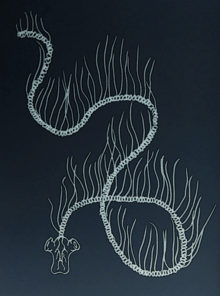Praya dubia
| Praya dubia | |
|---|---|
| Scientific classification | |
| Kingdom: | Animalia |
| Phylum: | Cnidaria |
| Class: | Hydrozoa |
| Order: | Siphonophora |
| Family: | Prayidae |
| Genus: | Praya |
| Species: | P. dubia |
| Binomial name | |
| Praya dubia (Quoy & Gaimard, 1827) | |
| Synonyms | |
| |

Praya dubia, or the giant siphonophore, is a deep sea siphonophore (living at 700 m to 1000 m below sea level), a member of the Hydrozoa. With a body length of 40 m (130 ft), Praya dubia is the second-longest sea organism. The giant siphonophore is not a single multicellular organism, but a colony of tiny minute organisms called zooids, each with a specific function, such as feeding, attack and defense. The zooids are all joined to each other to the extent that they are incapable of independent survival.[1] It is distributed through Atlantic Europe and the Gulf of Mexico.[2]
Description
Praya dubia has a dome-like section (the nectosome), sometimes referred to as the swimming bell, as well as long, thin sensory and stinging organs called siphosomes. Its body is whitish and transparent. Praya dubia attracts its prey with blue bioluminescent light. They deliver a powerful sting from the long, bell-like cells that make up the majority of the body. Their sting can cause paralysis or even death and is used to kill prey.[3]
When raised to the surface these animals burst, as they have a hydrostatic skeleton that normally experiences an average pressure of above 46 MPa (460 bar). Praya dubia has been known since the nineteenth century, but its length was discovered only after the Monterey Bay Aquarium Research Institute undertook a systematic study of the water column in 1987.[4][5]
References
- ↑ The Deep; the University of Chicago Press, London (2007)
- ↑ Kirkpatrick, P.A.; Pugh, P.R. (1984). Siphonophores and velellids: keys and notes for the identification of the species. Synopses of the British fauna (new series), 29. E.J. Brill/W. Backhuys: London, UK. ISBN 90-04-07470-8. vi, 154 pp.
- ↑ Terrain, the deep next door
- ↑ Praya dubia, at the Animal Diversity Web
- ↑ Praya dubia information